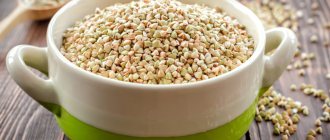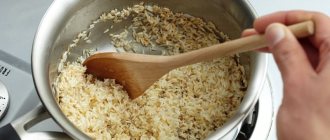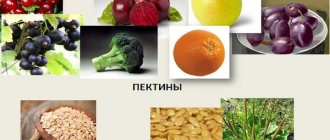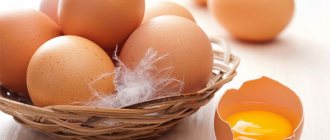Distribution history and species
Buckwheat has been familiar to people for a very long time. It is believed that it was first used as food five thousand years ago in the Himalayas, where it originally grew. Gradually, people realized that this cereal had many healing properties, they began to cultivate it more and more, and eventually it spread throughout the world. So this plant came to the territory of Russia from Greece, which is clear from its name, adopted in our language.
Buckwheat is usually divided into the following types:
- kernel or whole grain;
- product or grain that has a damaged structure;
- Smolensk groats - highly crushed buckwheat;
- buckwheat flour.
History of the origin of buckwheat
Buckwheat is a cereal obtained from the grains of the common buckwheat plant (Fagopyrum esculentum Moench). This food product is considered one of the main ones in Russia, Ukraine and Belarus. In America and European countries it is not so popular. Buckwheat can be purchased primarily in health food stores, but they also sell unroasted green grains.
The first to eat buckwheat were the inhabitants of Nepal and Northern India, who inhabited the Himalayas, more than 4 thousand years ago. The largest number of wild varieties of this plant grow in this area. Residents of the foothills noticed that insects love the flowers of this plant, and birds peck the grains. After this, people included green pyramids of seeds in their diet, and later began to fry them and cook porridge from them.
Buckwheat came to Kievan Rus thanks to the Volga Bulgarians, neighboring the peoples of the Himalayas. The mention of it in “The Tale of Igor’s Campaign” makes it possible to assert that this product was already a favorite among the Slavs.
Buckwheat appeared in Kievan Rus.
According to the main version, buckwheat got its name due to the fact that it was mainly cultivated by monks (Greeks) at monasteries. In addition, the plant has other names - “Tatarka”, “Saracenic grain”, “beech wheat”.
The latter appeared thanks to Karl Lineus, who gave buckwheat the Latin name Fagopyrum (“beech-like nut”) due to the external similarity of its seeds to beech nuts.
Chemical composition and nutritional value
So what substances is buckwheat rich in, why have people regularly been using it as food for several thousand years? Thanks to modern research, we know for sure that this cereal contains:
- vitamins of group B, A, E;
- calcium;
- iron;
- phosphorus;
- zinc;
- sulfur;
- fatty acid;
- citric and malic acid;
- fiber and many other microelements.
More than half (58%) of buckwheat consists of carbohydrates. It also contains proteins – 13%. But the fat in cereals is only 3%, and its calorie content is average - about 300 kcal per 100 grams.
Beneficial features
Considering the composition of the cereal, it becomes clear that with its regular use you can achieve the following results:
- cleanse the body of toxins and waste;
- strengthen blood vessels;
- improve heart function;
- lower cholesterol levels;
- normalize blood glucose;
- increase immunity;
- reduce the risk of anemia;
- get enough protein and amino acids for normal functioning of the body;
- increase endurance;
- minimize the impact of stress.
Benefits for women
The female body needs buckwheat to replenish iron deficiency, which can occur due to monthly bleeding. This product also allows you to maintain hair, skin and nails in good condition, and fight premature aging.
Buckwheat helps stop the development of varicose veins and strengthens bone tissue.
No less appreciated by the fair sex is the fact that cereals are perfect for the diet menu. It does not contain many calories, it cleanses the body of toxins and speeds up the metabolic process, which means it promotes faster weight loss.
Buckwheat products
On store shelves you can see not only raw light and dark cereals, buckwheat flour and flakes, but also ready-made bread. Each of these products has its own positive properties.
But it is worth mentioning separately buckwheat oil, the benefits of which for health and rejuvenation of the body have been proven by numerous scientific studies.
This product contains:
- Stearic acid, often used in anti-aging creams, as it eliminates flaking, relieves irritation and protects the skin from adverse environmental factors.
- Palmitic acid is involved in the production of collagen and elastin, which maintain skin tone and prevent the formation of wrinkles.
- Oleic acid has the ability to retain the necessary moisture in cells, prevent the negative effects of free active radicals on their membranes, and inhibit oxidation processes.
- Linoleic acid soothes the skin and prevents the formation of inflammation on it.
- All the minerals and vitamins that make up buckwheat remain in the oil. As a result, it helps the liver absorb vitamins, lowers cholesterol and normalizes blood sugar, promotes weight loss, improves immunity and activates the production of hormones.
When used internally, buckwheat oil protects the gastric mucosa from the formation of ulcers and promotes their healing. The only contraindication to the use of this product is its individual intolerance.
But buckwheat bread can easily replace traditional wheat or rye bread.
Benefits for pregnant women and nursing mothers
During pregnancy, buckwheat can become a reliable helper for the female body. It will make up for the lack of vitamins and nutrients during this important period, give the woman additional strength and energy, and due to the high content of folic acid and proteins, the fetus will develop without pathologies.
Allergies to buckwheat in babies are very rare, so a young mother may well eat buckwheat during lactation. In this way, both she and the child will receive the necessary dose of vitamins and nutrients required for the development of the baby’s muscles, bones and nervous system.
Attention! To completely eliminate the risk of allergies or other unwanted reactions in your baby, first consult your pediatrician about the use of buckwheat.
Benefits for men
Men who are actively involved in sports or simply have regular physical activity will appreciate buckwheat, because it makes the body more resilient, strengthens muscles and quickly satisfies the feeling of hunger.
Due to the fact that buckwheat improves blood circulation, it reduces the risk of stroke and heart attack, which most often affects the stronger sex.
The product can also improve potency and reduce the risk of prostate inflammation.
Colon cleansing with buckwheat
The optimal way to cleanse the intestines is a combination of buckwheat and kefir. Kefir is a natural probiotic that normalizes the microflora of the digestive system, and buckwheat promotes the normal functioning of all internal organs.
Doctor says
Anastasia Mertsalova
The combined opinion of doctors on this issue
The complex combination of buckwheat and kefir replenishes the water and salt balance and eliminates putrefactive processes in the body.
Take 1 tablespoon of washed buckwheat and pour a glass of kefir on the floor in the evening. You need to eat this half an hour before breakfast. For greater effectiveness, you can drink it with a glass of green tea.
But it is necessary to remember that kefir with buckwheat can provoke an exacerbation of pancreatitis, chronic diseases of the gastrointestinal tract and liver.
Benefits for children
Buckwheat is not only an approved product, but also recommended for baby food. You can start complementary feeding with it as early as 9-10 months of your baby’s life, even if he is still breastfed. Cereals will help the baby get the necessary acids and minerals, strengthen bone tissue, improve memory and attention.
Interesting fact: one of the distinctive characteristics of this cereal is the absence of gluten, which means the risk of developing allergies is very low.
Where did buckwheat come from?
The history of buckwheat goes back several thousand years. India is considered the birthplace of buckwheat, where the local population called this plant “black rice.” In the 15th century, exotic cereals first came to Greece, and from there they spread throughout Europe. It was in honor of Greece, which was the first to cultivate the plant, that buckwheat got its name. Europeans liked Indian grain, and even the ancient Scythians willingly bought it from the Greeks and called it “Greek grain.” But today the word “buckwheat” remains in the vocabulary of only the peoples of Eastern Europe. Western Europeans call cereal “Arab grain”, since the inhabitants of the East and Asia simply adore it and include it in the diet no less often than rice.
Hearty and healthy buckwheat porridge is the main dish for people on a diet; travelers often take it with them on hikes. If in Russia and Asia buckwheat is used mainly for culinary purposes, then in Western Europe buckwheat is cultivated mainly as a honey plant. Buckwheat honey is considered one of the most nutritious and healthy. Cooks all over the world prepare not only delicious porridge from buckwheat, but also a wide variety of products. Siberian peoples grind it into flour, from which they bake fragrant pancakes and cook soups. The Japanese make delicious noodles. But the Chinese have surpassed everyone: from buckwheat grains they make not only everyone’s favorite cereals and breads, but even chocolate, confitures and liqueurs.
Benefits for athletes and weight loss
Buckwheat will be a real help for those who regularly play sports. The amino acids included in its composition are an important element responsible for strengthening muscle tissue and bones. Vitamins give you energy, and you won't feel exhausted even after an intense workout. With such an energy value, there is very little fat in the cereal, which means it does not harm the figure.
All these qualities make buckwheat useful for those who follow a diet for weight loss. It helps not only to get rid of the feeling of hunger, but also gives a feeling of fullness - and this is what is so difficult for anyone who is trying to reduce the number of calories they eat.
If you want to give yourself a fasting day, then I recommend that you make buckwheat porridge for breakfast, although if you wish, you can use it as a main dish for both lunch and dinner. To diversify the menu and add flavor, combine cereals with fresh or steamed vegetables, as well as yogurt or kefir. Thus, your menu will remain sufficiently nutritious, but at the same time it will be lighter and less calorie.
On our website you can find recipes for dishes with this grain, such as classic porridge or buckwheat soup.
Buckwheat diet for weight loss
You need to follow this diet for 2 weeks. After this, you do not need to immediately return to your usual lifestyle, otherwise you can quickly return to your previous weight.
To maintain your new weight, you need to follow a few simple rules:
- Food should be stewed or steamed;
- It is necessary to exclude sweets and confectionery products from the diet;
- Return foods containing fats and carbohydrates to the diet gradually;
- Meat and lean fish should be eaten no more than 2 times a week;
- Include more vegetables and fruits in your diet;
- Don't eat at night;
- Lead an active lifestyle.
While on a buckwheat diet, you should not try to lose as many kilograms as possible, this is harmful to your health. Gradual weight loss gives more lasting results.
It is quite difficult to eat only buckwheat, so it can be diluted with fruits, vegetables, boiled lean beef. And another important condition when dieting is to drink more water, the recommended minimum is 1.5 liters.
Features of the buckwheat diet
- The most effective result is obtained if you eat one buckwheat throughout the day. You can drink porridge with kefir;
- Take 1 kg of cereal, divide it into 4 parts, cook the porridge and eat in small portions every 3 hours. You can drink it with water or yogurt;
- There is no need to add salt and spices to the porridge.
Menu for buckwheat diet
Sample menu:
- Breakfast. Properly prepared buckwheat porridge, you can add some dried fruits to it;
- Dinner . Baked or boiled chicken breast with stewed vegetables;
- Dinner . Buckwheat porridge with kefir.
While on any diet, you need to exercise. Choose the type of exercise depending on your health condition.
Buckwheat diet
The high content of vitamins and minerals in buckwheat is an undeniable argument for its inclusion in diets. But we must remember that excessive consumption of buckwheat is harmful for hypertensive patients, patients with diabetes, and people with gastrointestinal disorders.
The optimal option for consuming buckwheat is 1-2 times every 2-3 days. During the diet, buckwheat can be consumed in different forms 2 times a day. You can eat boiled buckwheat with kefir, or alternate with oatmeal.
Steamed or brewed in boiling water, it is the basis of many diets. Green buckwheat is especially useful; it is a real storehouse of useful elements.
If you use the buckwheat diet, you can lose weight up to 10 kg in 1-2 weeks, provided you do not violate the regime.
Diet rules
Nowadays, being overweight is a problem for many people. And to fight it, you need to combine exercise and proper nutrition.
The buckwheat diet belongs to the class of mono-diets. This means that you need to eat a strictly limited set of foods. Those who decide to try the buckwheat diet should know that it is not suitable for everyone. And if you manage to lose a few kilograms, in the future you will have to make a lot of effort in order to maintain the result.
The buckwheat diet is one of the group of mono-product diets that does not require quantitative restrictions on products. It got its name from the main product used in the diet – buckwheat.
Source Wikipedia
The duration of the diet is usually 3-5 days, but some people manage to stay on it for 10-14 days.
The list of foods for the diet is very limited. The main product, of course, is buckwheat. You can eat it as much as you feel hungry. Every day I want to eat buckwheat porridge less and less. This is exactly what the diet is built on: a person eats less, so the excess weight goes away.
The porridge is prepared every day according to the same recipe. Take buckwheat, rinse it and fill it with hot water in a 1:2 ratio. Cover the pan tightly with a lid and leave overnight. By morning the porridge is ready.
Diet Basics
When eating buckwheat, it is important to observe some points:
- Only permitted foods should be present in the diet; you cannot add or remove anything on your own;
- It is necessary to drink a sufficient amount of clean water during the day - approximately 1.5-2 liters;
- You cannot add salt, flavor enhancers, sauces or seasonings to the porridge;
- To consolidate the result, you must follow the rules for exiting the diet, otherwise the weight may return again.
The rules are quite strict, so not every person can withstand such a diet.
Is it possible to eat every day
I think many of us have wondered: is it possible to eat buckwheat every day? Theoretically, yes. It does not contain harmful fats and cholesterol; on the contrary, it contains more than enough vitamins. But in reality, as with all products, you need to remember in moderation. Try to combine and alternate buckwheat with other types of cereals, vegetables and fruits so that your body receives the maximum possible amount of vitamins and microelements.
It is believed that the daily requirement of buckwheat for an adult is no more than 200 grams. At the same time, if possible, it is preferable to consume it in the morning to activate metabolism and get enough energy for the rest of the day.
What about carbohydrates?
Many of you may ask the question, how can buckwheat help you lose weight or improve your health when it contains so many carbohydrates in any form, boiled or raw. After all, they say everywhere now that if you want to be slim, then no carbohydrates. And even more so, they affect the deposition of fat, especially on the hips and abdomen, and cause cellulite. Yes, you are right, besides, carbohydrates can cause a sharp jump in blood sugar levels, which is contraindicated for diabetics. There can be no talk about health and weight loss here. Only this effect is caused by fast carbohydrates, and buckwheat is a complex or, as they also say, slow type of carbohydrates.
Such complex carbohydrates are represented by coarse fibers or cellulose in cereals. These substances give a feeling of fullness for a very long time; they are not completely absorbed by the body, but cleanse the gastrointestinal tract, freeing our body from harmful accumulations. As a result, our metabolism and digestion are normalized, weight begins to gradually decrease, and, in general, our appearance becomes more attractive.
Beneficial properties of green and sprouted buckwheat
We are accustomed to the fact that buckwheat is dark brown in color. Not everyone may know, but the core gets this shade when fried. If it is not thermally treated, it will retain its natural green tint. Recently, such buckwheat has become easy to find in stores. It is believed that it contains more useful substances - because it was not exposed to high temperatures.
Most often, green buckwheat is recommended for cleansing the body of toxins, because it retains more fiber than fried cereals.
The method of preparing green buckwheat is no different from the usual one: pour boiling water over it and cook until tender for 15-20 minutes.
You can learn more about the classic method of preparing cereals from the video:
However, if desired, you can also use the so-called steaming method. Buckwheat should be poured with hot water and left for several hours until it becomes soft. Then you can add milk, salt and a little butter to the dish.
Green cereals are also suitable for sprouting. Buckwheat sprouts help cope with constipation, increase appetite and regulate metabolism.
Sprouted kernels are best added to vegetable salads or used on their own as a side dish to facilitate liver function and speed up the digestion process.
How to cook buckwheat correctly
Proper preparation of buckwheat involves heat treatment, which will preserve the maximum of beneficial substances contained in it. To do this you need:
- Carefully sort through the cereal, removing from it all large debris and husks that might remain.
- Rinse the grains thoroughly in cold water 2-3 times. This will remove small debris and dust.
- Pour water twice the volume of cereal into a saucepan (necessarily with a thick bottom and walls) and put on fire.
- Salt boiling water and add prepared buckwheat to it. As soon as the contents of the pan boil, cover it with a lid and reduce the heat to low. The porridge should not boil, but steam.
- After 20 minutes, when the buckwheat is ready, turn off the heat, add a piece of butter, stir and let stand for a while under the lid.
Those who agree to wait in order to preserve the benefits of the product can use the following method:
- The grains are sorted, washed and transferred to a thick-walled saucepan or ceramic pot.
- The water is brought to a boil, salt is added and the grains are poured with boiling water.
- Wrap the pan in a warm blanket and leave it for 10-12 hours, preferably overnight, and in the morning you can enjoy a properly prepared healthy product.
A modern assistant for many housewives, a multicooker will also allow you to properly prepare buckwheat porridge. If the device does not have a special function for preparing this cereal, the “Porridge”, “Rice” or “Milk porridge” modes are suitable.











